Extensive Therapeutic Drug Monitoring of Colistin in Critically Ill Patients Reveals Undetected Risks
Abstract
1. Introduction
2. Materials and Methods
2.1. Patient Samples
2.2. Dosing
2.3. Sample Preparation and Detection of CMS and Colistin by HPLC-MS/MS
2.4. Liquid Chromatography Mass Spectrometry
2.5. Statistics
2.6. Ethics Approval
3. Results and Discussion
3.1. Patient Characteristics
3.2. Effects on Acute Renal Insufficiency without CRRT on Achieved Colistin Plasma Levels
3.3. Development of Colistin Accumulation and Renal Failure following Increased Colistin Doses, Mandated by Colistin Target Levels
3.4. Effective Colistin Treatment Led to Accumulation Despite of a “Nephro Shield” Strategy with CRRT
3.5. Elimination of CMS trough CRRT can Impair/Prevent Achievement of Sufficient Drug Target Levels
3.6. Failure to Rescue: IHD Strategy Does not Necessarily Prevent Accumulation of Potentially Toxic Colistin Drug Levels
3.7. High Colistin Plasma Levels do not Prevent Development of Colistin Resistance, Despite Prolonged Treatment
3.8. Constant Colistin Levels can be Achieved with Lowered Doses at Higher Intervals under CRRT. Extended Interval Application might Fail
- Monitoring of renal function on a daily basis is crucial. However, adherence to the guideline-based dose adjustments for renal function/RRT does not necessarily facilitate adequate CMS/Colistin plasma levels. Both, over- and underdosing, were observed.
- DAILY monitoring of both Colistin and CMS trough levels is necessary, as Colistin plasma levels do not correlate with CMS levels (Figure 1B–D). This might prevent unobserved accumulation of Colistin, if TDM is available in a timely fashion. Monitoring of CMS trough levels allows for detection of pro-drug accumulation.
- Colistin elimination appears to be unchanged by CRRT and is prolonged in critically ill patients (Figure 2).
- Use of CRRT/IHD might rapidly eliminate CMS and thus diminish the available pro-drug when accumulation is observed. CRRT can lead to underdosing, thereby mandating a dose increase (Figure 6). On the other hand, overdosing might still occur/persist despite RRT. Without extensive TDM, both phenomena would remain undetected.
- Early termination of treatment should be considered, if accumulation occurs, since omission of loading dose can lead to prolonged times with Colistin below target levels (Figure 3, Figure 4 and Figure 6). Thus, use of a loading dose to rapidly achieve relevant target levels, as suggested by others [13,15,24,37], appears to be mandatory. Furthermore, an auxiliary dose might help to rapidly achieve target levels when dose increase becomes necessary.
3.9. Study Limitations
4. Conclusions
Supplementary Materials
Author Contributions
Funding
Acknowledgments
Conflicts of Interest
Abbreviations
| CRRT | Continuous Renal Replacement Therapy |
| CVVHD | Continuous Veno-Venous Hemo-Dialysis |
| CVVHDF | Continuous venovenous hemodiafiltration |
| CMS | Colisthimethate sodium |
| CRAB | Carbapenem resistant A. baumannii |
| eGFR | estimated glomerular filtration rate |
| ICU | Intensive Care Unit |
| IHD | Intermittent Hemodialysis |
| IQR | Interquartile Range |
| MDR | Multidrug resistant |
| PDR | Pan drug resistant |
| RRT | Renal replacement therapy |
| SOFA | Sequential Organ Failure Assessment |
| TDM | Therapeutic Drug Monitoring |
References
- Solomon, S.L.; Oliver, K.B. Antibiotic Resistance Threats in the United States. Am. Fam. Physician 2014, 82, 938–941. [Google Scholar]
- Magiorakos, A.-P.; Srinivasan, A.; Carey, R.B.; Carmeli, Y.; Falagas, M.E.; Giske, C.G.; Harbarth, S.; Hindler, J.F.; Kahlmeter, G.; Olsson-Liljequist, B.; et al. Multidrug-resistant, extensively drug-resistant and pandrug-resistant bacteria: An international expert proposal for interim standard definitions for acquired resistance. Clin. Microbiol. Infect. 2012, 18, 268–281. [Google Scholar] [CrossRef]
- Ben-David, D.; Kordevani, R.; Keller, N.; Tal, I.; Marzel, A.; Gal-Mor, O.; Maor, Y.; Rahav, G. Outcome of carbapenem resistant Klebsiella pneumoniae bloodstream infections. Clin. Microbiol. Infect. 2012, 18, 54–60. [Google Scholar] [CrossRef] [PubMed]
- Viale, P.; Giannella, M.; Lewis, R.; Trecarichi, E.M.; Petrosillo, N.; Tumbarello, M. Predictors of mortality in multidrug-resistant Klebsiella pneumoniae bloodstream infections. Expert Rev. Anti Infect. Ther. 2013, 11, 1053–1063. [Google Scholar] [CrossRef] [PubMed]
- Bergen, P.J.; Landersdorfer, C.B.; Lee, H.J.; Li, J.; Nation, R.L. “Old” antibiotics for emerging multidrug-resistant bacteria. Curr. Opin. Infect. Dis. 2012, 25, 626–633. [Google Scholar] [CrossRef] [PubMed]
- Walkty, A.; DeCorby, M.; Nichol, K.; Karlowsky, J.A.; Hoban, D.J.; Zhanel, G.G. In vitro activity of colistin (polymyxin E) against 3480 isolates of gram-negative bacilli obtained from patients in Canadian hospitals in the CANWARD study, 2007–2008. Antimicrob. Agents Chemother. 2009, 53, 4924–4926. [Google Scholar] [CrossRef] [PubMed]
- Kwa, A.L.; Tam, V.H.; Falagas, M.E. Polymyxins: A review of the current status including recent developments. Ann. Acad. Med. Singap. 2008, 37, 870–883. [Google Scholar]
- Koch-Weser, J.; Sidel, V.W.; Federman, E.B.; Kanarek, P.; Finer, D.C.; Eaton, A.E. Adverse effects of sodium colistimethate. Manifestations and specific reaction rates during 317 courses of therapy. Ann. Intern. Med. 1970, 72, 857–868. [Google Scholar] [CrossRef]
- Couet, W.; Grégoire, N.; Marchand, S.; Mimoz, O. Colistin pharmacokinetics: The fog is lifting. Clin. Microbiol. Infect. 2012, 18, 30–39. [Google Scholar] [CrossRef]
- Bergen, P.J.; Li, J.; Rayner, C.R.; Nation, R.L. Colistin methanesulfonate is an inactive prodrug of colistin against Pseudomonas aeruginosa. Antimicrob. Agents Chemother. 2006, 50, 1953–1958. [Google Scholar] [CrossRef]
- Grégoire, N.; Aranzana-Climent, V.; Magréault, S.; Marchand, S.; Couet, W. Clinical Pharmacokinetics and Pharmacodynamics of Colistin. Clin. Pharmacokinet. 2017, 56, 1441–1460. [Google Scholar] [CrossRef] [PubMed]
- Gauthier, T.P.; Wolowich, W.R.; Reddy, A.; Cano, E.; Abbo, L.; Smith, L.B. Incidence and predictors of nephrotoxicity associated with intravenous colistin in overweight and obese patients. Antimicrob. Agents Chemother. 2012, 56, 2392–2396. [Google Scholar] [CrossRef] [PubMed]
- Garonzik, S.M.; Li, J.; Thamlikitkul, V.; Paterson, D.L.; Shoham, S.; Jacob, J.; Silveira, F.P.; Forrest, A.; Nation, R.L. Population Pharmacokinetics of Colistin Methanesulfonate and Formed Colistin in Critically Ill Patients from a Multicenter Study Provide Dosing Suggestions for Various Categories of Patients. Antimicrob. Agents Chemother. 2011, 55, 3284–3294. [Google Scholar] [CrossRef] [PubMed]
- Tsuji, B.T.; Pogue, J.M.; Zavascki, A.P.; Paul, M.; Daikos, G.L.; Forrest, A.; Giacobbe, D.R.; Viscoli, C.; Giamarellou, H.; Karaiskos, I.; et al. International Consensus Guidelines for the Optimal Use of the Polymyxins: Endorsed by the American College of Clinical Pharmacy (ACCP), European Society of Clinical Microbiology and Infectious Diseases (ESCMID), Infectious Diseases Society of America (IDSA), International Society for Anti-infective Pharmacology (ISAP), Society of Critical Care Medicine (SCCM), and Society of Infectious Diseases Pharmacists (SIDP). Pharmacotherapy 2019, 39, 10–39. [Google Scholar]
- Nation, R.L.; Garonzik, S.M.; Thamlikitkul, V.; Giamarellos-Bourboulis, E.J.; Forrest, A.; Paterson, D.L.; Li, J.; Silveira, F.P. Dosing guidance for intravenous colistin in critically-ill patients. Clin. Infect. Dis. 2017, 64, 565–571. [Google Scholar] [CrossRef]
- Levey, A.S.; Stevens, L.A.; Schmid, C.H.; Zhang, Y.L.; Castro, A.F.; Feldman, H.I.; Kusek, J.W.; Eggers, P.; Van Lente, F.; Greene, T.; et al. A new equation to estimate glomerular filtration rate. Ann. Intern. Med. 2009, 150, 604–612. [Google Scholar] [CrossRef]
- Daikos, G.L.; Skiada, A.; Pavleas, J.; Vafiadi, C.; Salatas, K.; Tofas, P.; Tzanetou, K.; Markogiannakis, A.; Thomopoulos, G.; Vafiadi, I.; et al. Serum bactericidal activity of three different dosing regimens of colistin with implications for optimum clinical use. J. Chemother. 2010, 22, 175–178. [Google Scholar] [CrossRef]
- Vincent, J.L.; Moreno, R.; Takala, J.; Willatts, S.; De Mendonca, A.; Bruining, H.; Reinhart, C.K.; Suter, P.M.; Thijs, L.G. The SOFA (Sepsis-related Organ Failure Assessment) score to describe organ dysfunction/failure. On behalf of the Working Group on Sepsis-Related Problems of the European Society of Intensive Care Medicine. Intensive Care Med. 1996, 22, 707–710. [Google Scholar] [CrossRef]
- Bergen, P.J.; Landersdorfer, C.B.; Zhang, J.; Zhao, M.; Lee, H.J.; Nation, R.L.; Li, J. Pharmacokinetics and pharmacodynamics of “old” polymyxins: What is new? Diagn. Microbiol. Infect. Dis. 2012, 74, 213–223. [Google Scholar] [CrossRef]
- Michalopoulos, A.S.; Falagas, M.E. Colistin: Recent data on pharmacodynamics properties and clinical efficacy in critically ill patients. Ann. Intensive Care 2011, 1, 30. [Google Scholar] [CrossRef]
- Plachouras, D.; Karvanen, M.; Friberg, L.E.; Papadomichelakis, E.; Antoniadou, A.; Tsangaris, I.; Karaiskos, I.; Poulakou, G.; Kontopidou, F.; Armaganidis, A.; et al. Population Pharmacokinetic Analysis of Colistin Methanesulfonate and Colistin after Intravenous Administration in Critically Ill Patients with Infections Caused by Gram-Negative Bacteria. Antimicrob. Agents Chemother. 2009, 53, 3430–3436. [Google Scholar] [CrossRef] [PubMed]
- Grégoire, N.; Mimoz, O.; Mégarbane, B.; Comets, E.; Chatelier, D.; Lasocki, S.; Gauzit, R.; Balayn, D.; Gobin, P.; Marchand, S.; et al. New Colistin Population Pharmacokinetic Data in Critically Ill Patients Suggesting an Alternative Loading Dose Rationale. Antimicrob. Agents Chemother. 2014, 58, 7324–7330. [Google Scholar] [CrossRef] [PubMed]
- Lim, L.M.; Ly, N.; Anderson, D.; Yang, J.C.; Macander, L.; Jarkowski, A.; Forrest, A.; Bulitta, J.B.; Tsuji, B.T. Resurgence of colistin: A review of resistance, toxicity, pharmacodynamics, and dosing. Pharmacotherapy 2010, 30, 1279–1291. [Google Scholar] [CrossRef] [PubMed]
- Schmidt, J.J.; Strunk, A.-K.; David, S.; Bode-Böger, S.M.; Martens-Lobenhoffer, J.; Knitsch, W.; Scherneck, S.; Welte, T.; Kielstein, J.T. Single- and multiple-dose pharmacokinetics and total removal of colistin in critically ill patients with acute kidney injury undergoing prolonged intermittent renal replacement therapy. J. Antimicrob. Chemother. 2019, 74, 997–1002. [Google Scholar] [CrossRef] [PubMed]
- Gupta, S.; Govil, D.; Kakar, P.N.; Prakash, O.; Arora, D.; Das, S.; Govil, P.; Malhotra, A. Colistin and polymyxin B: A re-emergence. Indian J. Crit. Care Med. 2009, 13, 49–53. [Google Scholar] [PubMed]
- Honore, P.M.; Jacobs, R.; Hendrickx, I.; De Waele, E.; Van Gorp, V.; Spapen, H.D. Higher colistin dose during continuous renal replacement therapy: Look before leaping! Crit. Care 2015, 19, 235. [Google Scholar] [CrossRef] [PubMed][Green Version]
- Honoré, P.M.; Jacobs, R.; Joannes-Boyau, O.; Lochy, S.; Boer, W.; De Waele, E.; Van Gorp, V.; De Regt, J.; Collin, V.; Spapen, H.D. Continuous renal replacement therapy-related strategies to avoid colistin toxicity: A clinically orientated review. Blood Purif. 2014, 37, 291–295. [Google Scholar] [CrossRef]
- Honore, P.; Jacobs, R.; Joannes-Boyau, O.; Spapen, H.; Boer, W.; De Waele, E.; Gorp, V. Continuous renal replacement therapy allows higher colistin dosing without increasing toxicity. J. Transl. Intern. Med. 2013, 1, 6. [Google Scholar] [CrossRef]
- Dalfino, L.; Puntillo, F.; Mosca, A.; Monno, R.; Spada, M.L.; Coppolecchia, S.; Miragliotta, G.; Bruno, F.; Brienza, N. High-dose, extended-interval colistin administration in critically ill patients: Is this the right dosing strategy? A preliminary study. Clin. Infect. Dis. 2012, 54, 1720–1726. [Google Scholar] [CrossRef]
- Li, J.; Rayner, C.R.; Nation, R.L.; Owen, R.J.; Spelman, D.; Tan, K.E.; Liolios, L. Heteroresistance to colistin in multidrug-resistant Acinetobacter baumannii. Antimicrob. Agents Chemother. 2006, 50, 2946–2950. [Google Scholar] [CrossRef]
- Falagas, M.E.; Rafailidis, P.I.; Matthaiou, D.K.; Virtzili, S.; Nikita, D.; Michalopoulos, A. Pandrug-resistant Klebsiella pneumoniae, Pseudomonas aeruginosa and Acinetobacter baumannii infections: Characteristics and outcome in a series of 28 patients. Int. J. Antimicrob. Agents 2008, 32, 450–454. [Google Scholar] [CrossRef] [PubMed]
- Falagas, M.E.; Rafailidis, P.I.; Matthaiou, D.K. Resistance to polymyxins: Mechanisms, frequency and treatment options. Drug Resist. Updates 2010, 13, 132–138. [Google Scholar] [CrossRef] [PubMed]
- Bialvaei, A.Z.; Samadi Kafil, H. Colistin, mechanisms and prevalence of resistance. Curr. Med. Res. Opin. 2015, 31, 707–721. [Google Scholar] [CrossRef] [PubMed]
- Mattner, F.; Bange, F.-C.; Meyer, E.; Seifert, H.; Wichelhaus, T.A.; Chaberny, I.F. Preventing the spread of multidrug-resistant gram-negative pathogens: recommendations of an expert panel of the German Society For Hygiene and Microbiology. Dtsch. Arztebl. Int. 2012, 109, 39–45. [Google Scholar]
- Olaitan, A.O.; Morand, S.; Rolain, J.-M. Mechanisms of polymyxin resistance: Acquired and intrinsic resistance in bacteria. Front. Microbiol. 2014, 5, 643. [Google Scholar] [CrossRef]
- Peter, S.; Bezdan, D.; Oberhettinger, P.; Vogel, W.; Dörfel, D.; Dick, J.; Marschal, M.; Liese, J.; Weidenmaier, C.; Autenrieth, I.; et al. Whole-genome sequencing enabling the detection of a colistin-resistant hypermutating Citrobacter werkmanii strain harbouring a novel metallo-β-lactamase VIM-48. Int. J. Antimicrob. Agents 2018, 51, 867–874. [Google Scholar] [CrossRef]
- Markou, N.; Markantonis, S.L.; Dimitrakis, E.; Panidis, D.; Boutzouka, E.; Karatzas, S.; Rafailidis, P.; Apostolakos, H.; Baltopoulos, G. Colistin serum concentrations after intravenous administration in critically ill patients with serious multidrug-resistant, gram-negative bacilli infections: A prospective, open-label, uncontrolled study. Clin. Ther. 2008, 30, 143–151. [Google Scholar] [CrossRef]
- Corona, A.; Cattaneo, D. Dosing Colistin Properly: Let’s Save “Our Last Resort Old Drug”! Clin. Infect. Dis. 2017, 65, 870. [Google Scholar] [CrossRef]
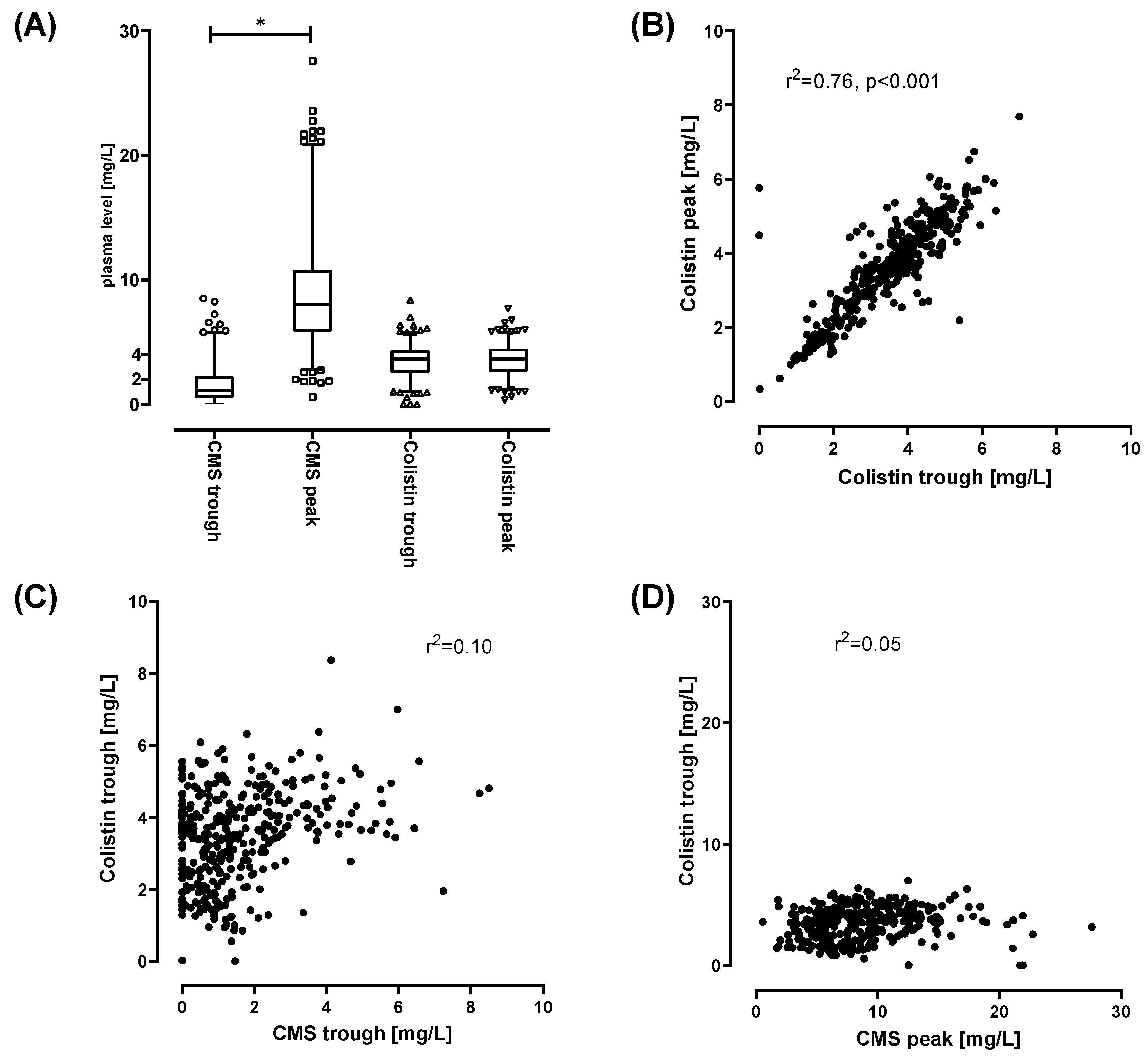
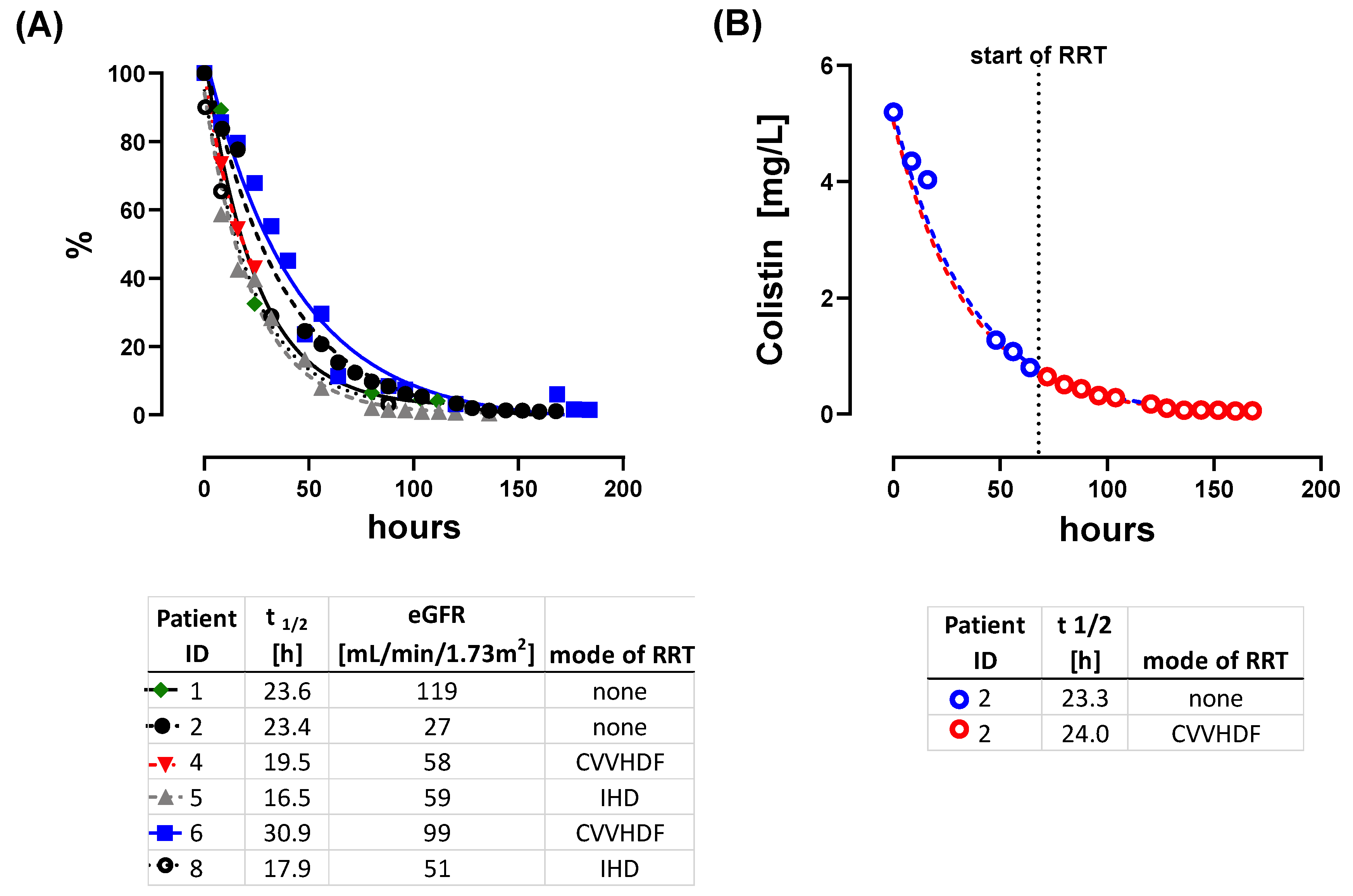

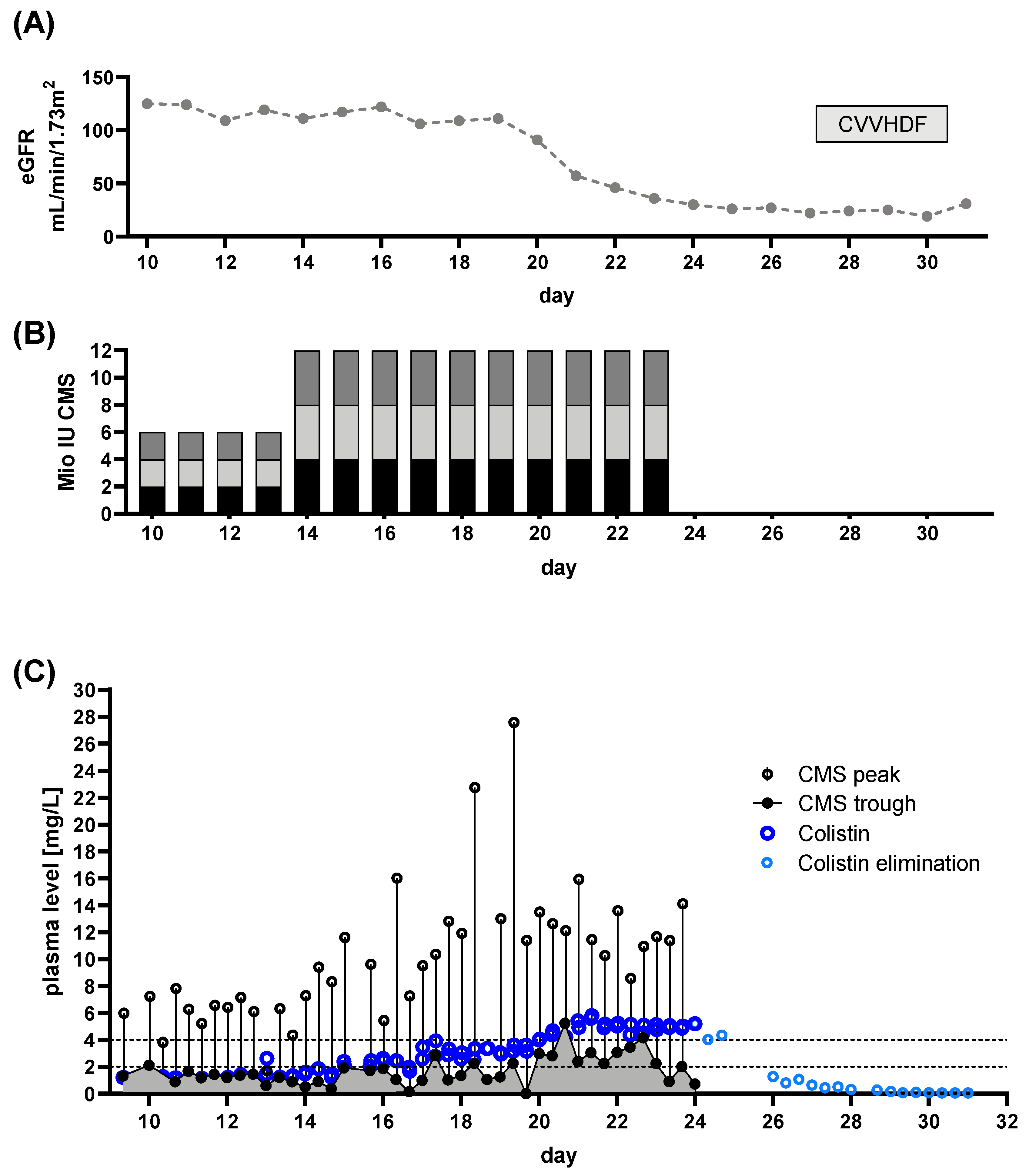
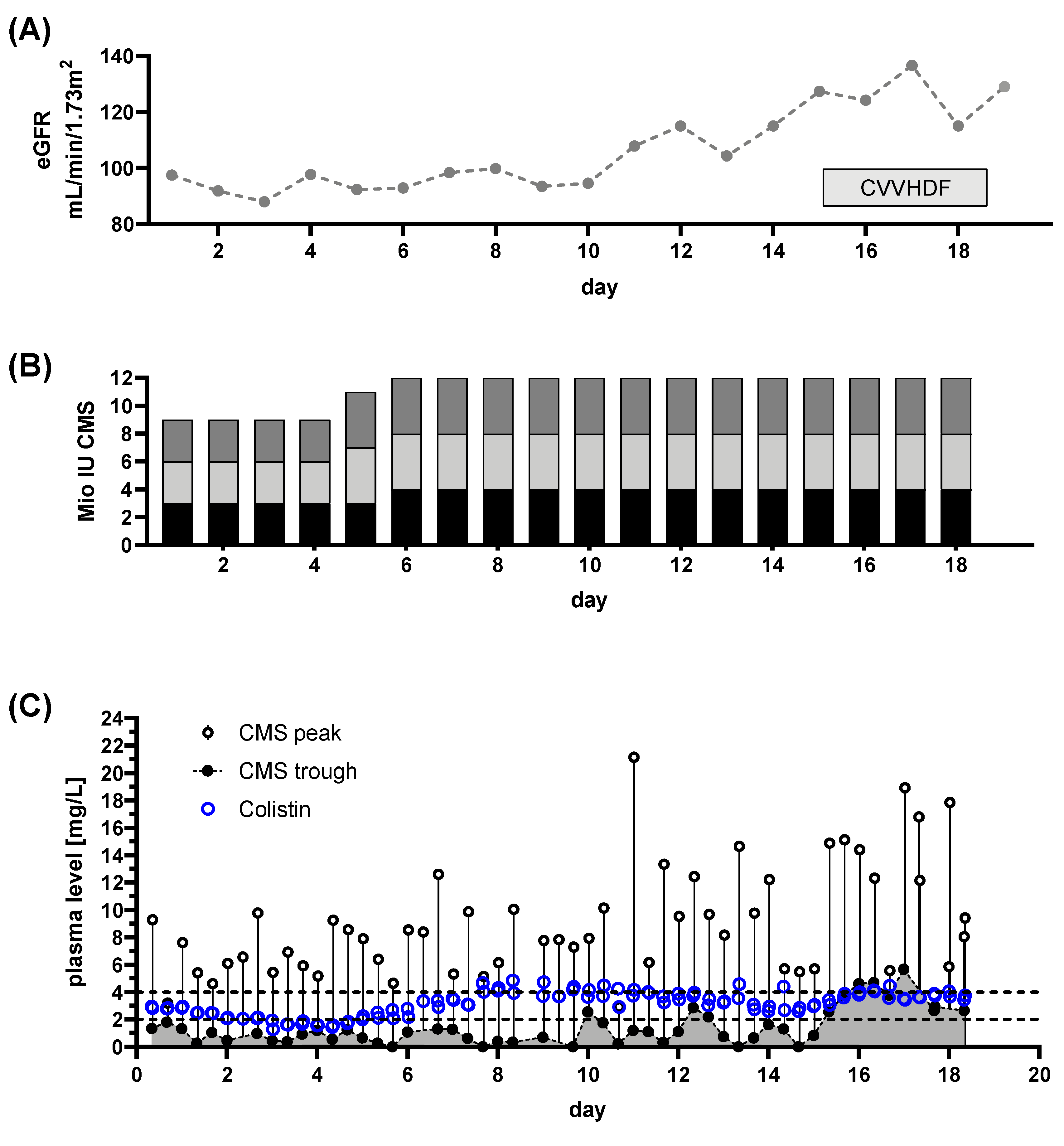
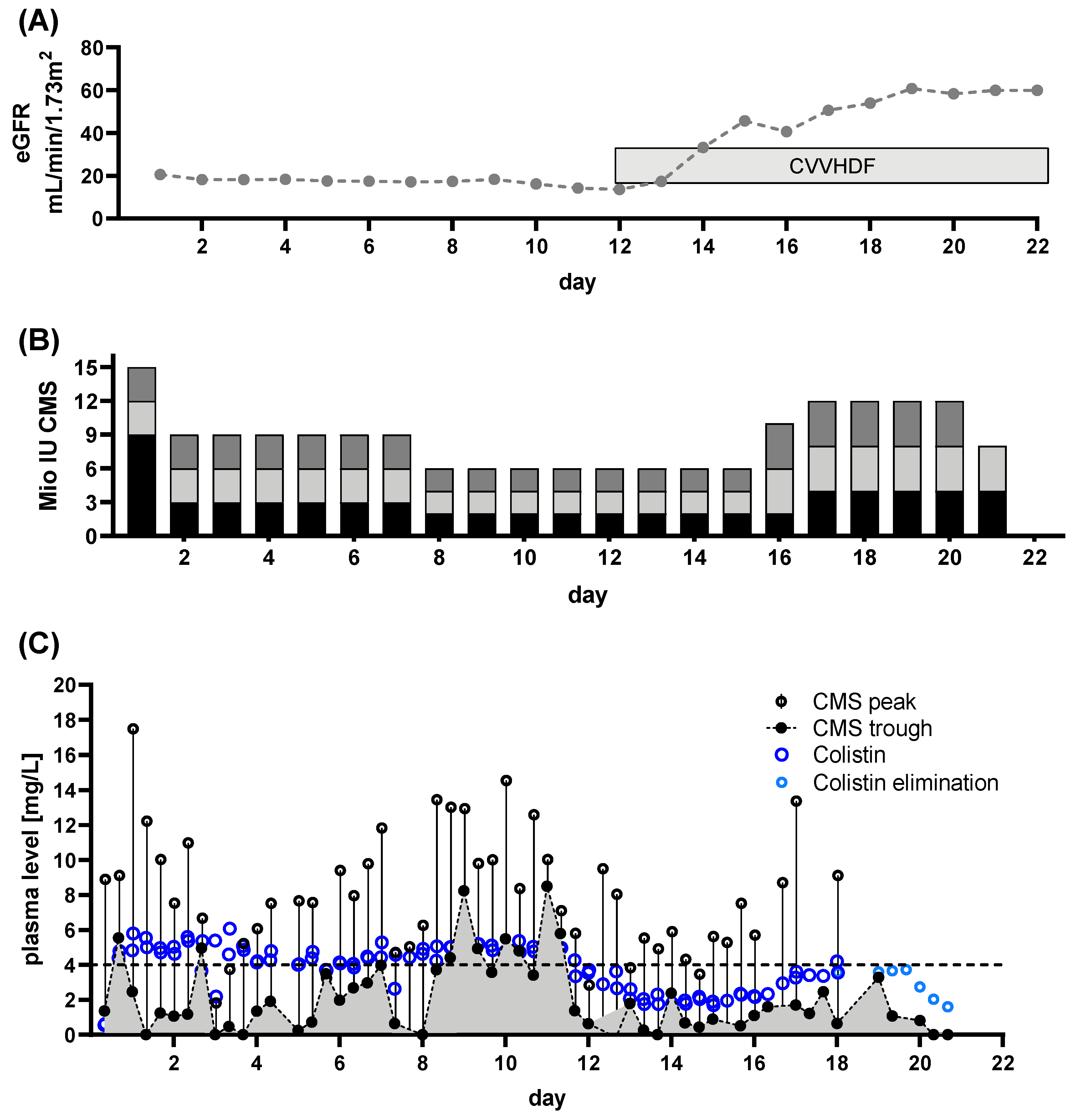
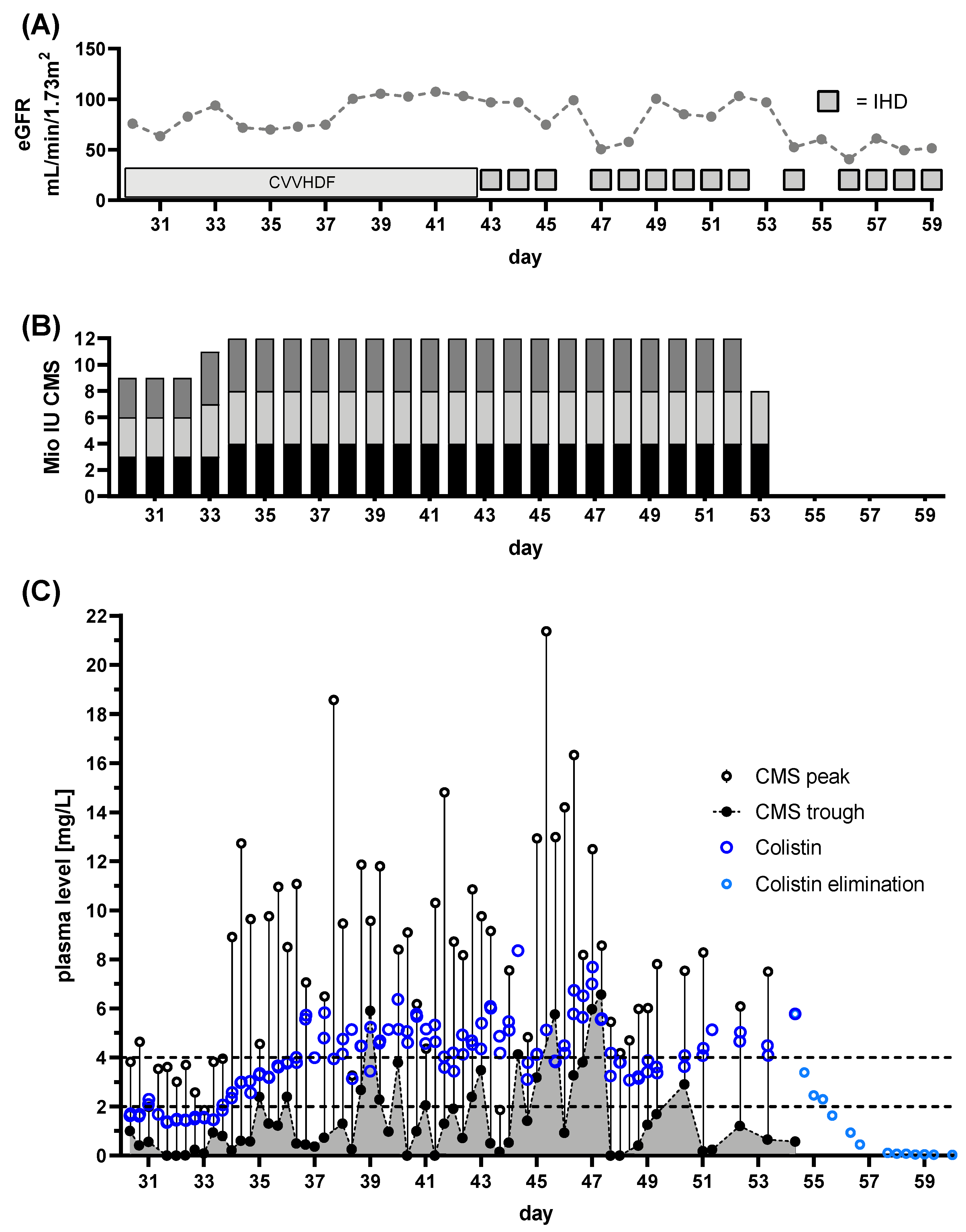
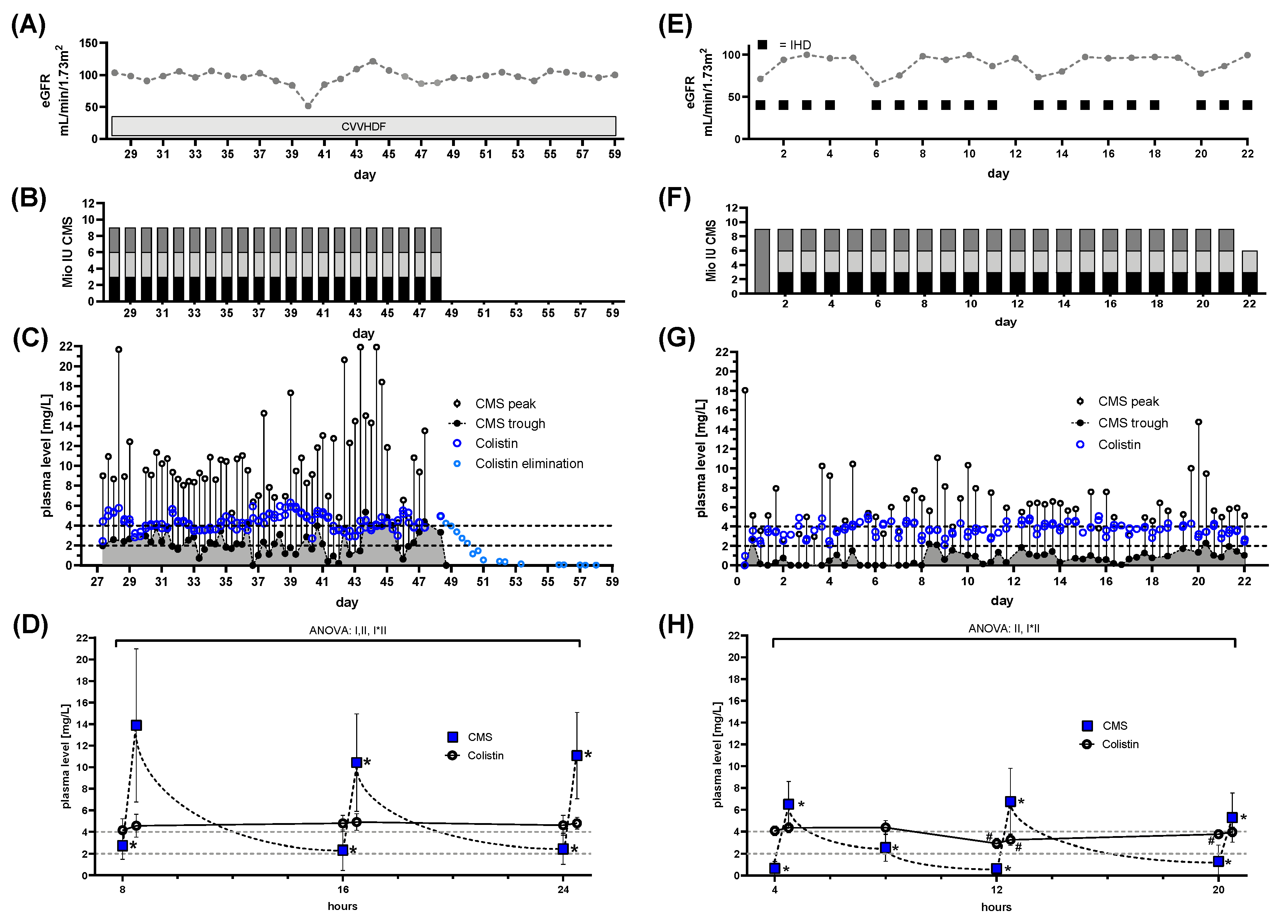
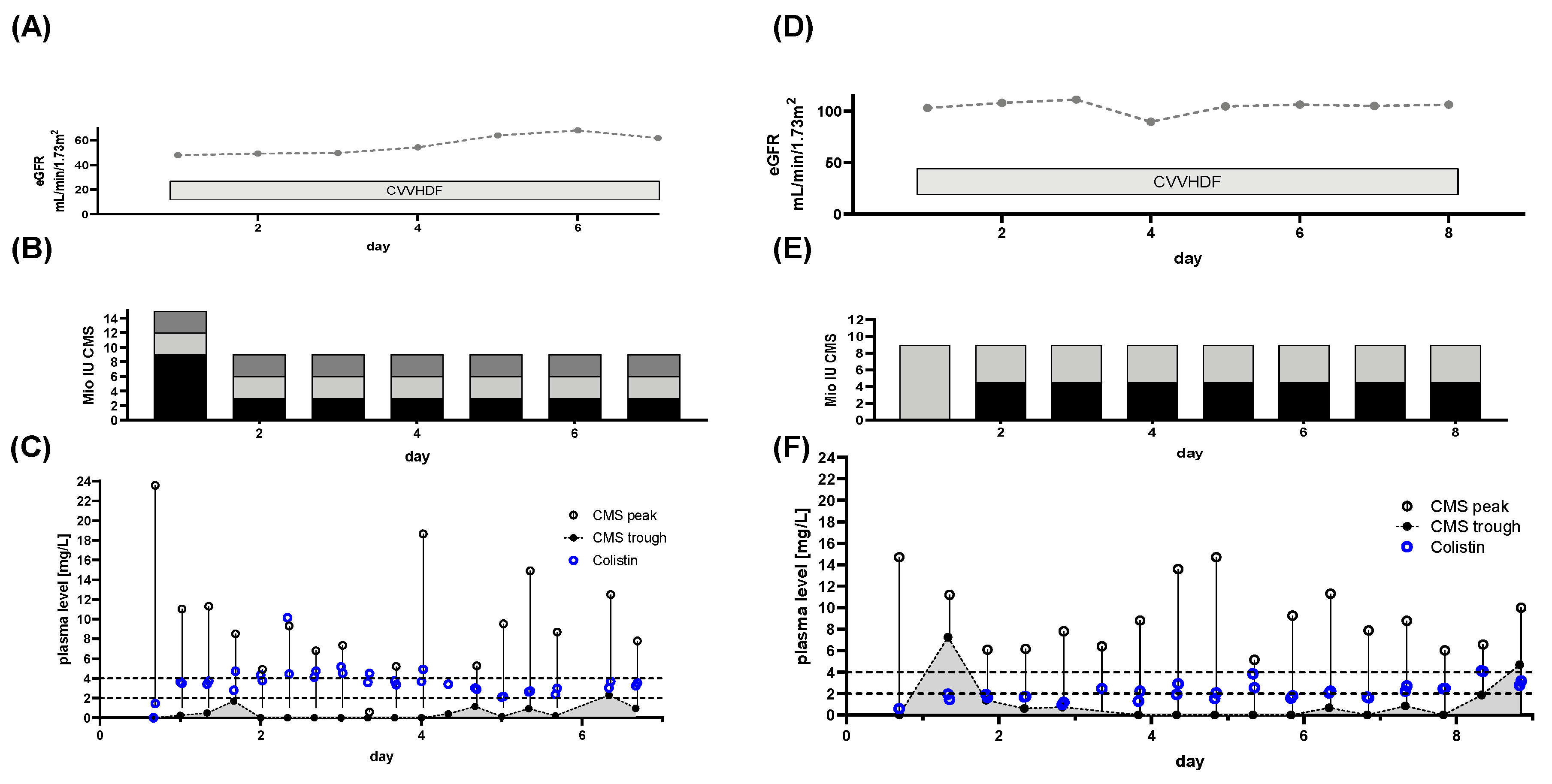
| Pat ID | Age at Admission [y] | Weight [kg] | Height [cm] | BMI [kg/m2] | ICU LOS [d] | Number of Days on Colistin | SOFA Score at Admission | SOFA Score at Start of CMS Treatment | Site of Infection | Gram Negative PDR Pathogens | RRT |
|---|---|---|---|---|---|---|---|---|---|---|---|
| 1 | 62 | 85 | 175 | 27.8 | 17 | 7 | 10 | 10 | Wound infection, pulmonary infection + colonization | A. baumannii, E. cloacae, K. pneumoniae | None |
| 2 | 73 | 85 | 175 | 27.8 | 87 | 52 | 7 | 3 | Blood stream, pulmonary+ colonization | A. baumannii | Post treatment (CVVHDF) |
| 3 | 75 | 100 | 170 | 34.0 | 50 | 29 | 7 | 10 | Blood stream, wound infection + colonization | A. baumannii, P. aeruginosa | CVVHDF |
| 4 | 76 | 85 | 170 | 29.0 | 497 | 19 | 8 | 8 | Wound infection, pulmonary infection + colonization | P. aeruginosa | CVVHDF |
| 5 | 54 | 100 | 168 | 34.6 | 145 | 54 | 15 | 15 | Blood stream, pulmonary, wound infection, urinary tract infection + colonization | A. baumannii | CVVHDF, IHD |
| 6.1 | 61 | 50 | 168 | 17.7 | 161 | 38 | 14 | 8 | Blood stream, pulmonary+ colonization | A. baumannii | CVVHDF |
| 6.2 | 22 | 14 | 11 | Blood stream, pulmonary+ colonization | A. baumannii | IHD | |||||
| 7.1 | 49 | 125 | 165 | 45.9 | 91 | 6 | 1 | 15 | Wound infection, pulmonary infection + colonization | A. baumannii | CVVHDF |
| 7.2 | 7 | 1 | 9 | Blood stream, wound infection (colistin resistant), + colonization | A. baumannii | CVVHDF | |||||
| 8 | 47 | 68 | 168 | 24.1 | 26 | 3 | 7 | 13 | Pulmonary infection, wound infection | P. aeruginosa | IHD |
© 2020 by the authors. Licensee MDPI, Basel, Switzerland. This article is an open access article distributed under the terms and conditions of the Creative Commons Attribution (CC BY) license (http://creativecommons.org/licenses/by/4.0/).
Share and Cite
Ehrentraut, S.F.; Muenster, S.; Kreyer, S.; Theuerkauf, N.U.; Bode, C.; Steinhagen, F.; Ehrentraut, H.; Schewe, J.-C.; Weber, M.; Putensen, C.; et al. Extensive Therapeutic Drug Monitoring of Colistin in Critically Ill Patients Reveals Undetected Risks. Microorganisms 2020, 8, 415. https://doi.org/10.3390/microorganisms8030415
Ehrentraut SF, Muenster S, Kreyer S, Theuerkauf NU, Bode C, Steinhagen F, Ehrentraut H, Schewe J-C, Weber M, Putensen C, et al. Extensive Therapeutic Drug Monitoring of Colistin in Critically Ill Patients Reveals Undetected Risks. Microorganisms. 2020; 8(3):415. https://doi.org/10.3390/microorganisms8030415
Chicago/Turabian StyleEhrentraut, Stefan Felix, Stefan Muenster, Stefan Kreyer, Nils Ulrich Theuerkauf, Christian Bode, Folkert Steinhagen, Heidi Ehrentraut, Jens-Christian Schewe, Matthias Weber, Christian Putensen, and et al. 2020. "Extensive Therapeutic Drug Monitoring of Colistin in Critically Ill Patients Reveals Undetected Risks" Microorganisms 8, no. 3: 415. https://doi.org/10.3390/microorganisms8030415
APA StyleEhrentraut, S. F., Muenster, S., Kreyer, S., Theuerkauf, N. U., Bode, C., Steinhagen, F., Ehrentraut, H., Schewe, J.-C., Weber, M., Putensen, C., & Muders, T. (2020). Extensive Therapeutic Drug Monitoring of Colistin in Critically Ill Patients Reveals Undetected Risks. Microorganisms, 8(3), 415. https://doi.org/10.3390/microorganisms8030415






